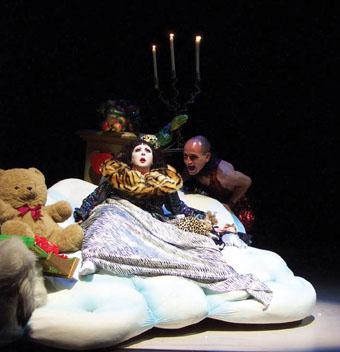A Shakespearean Mix
Mary Ann Hunter

Frank Theatre, Midsummer Night’s Romeos
photo Kelly Berggren
Frank Theatre, Midsummer Night’s Romeos
Draped over extravagant fluffy-cloud settees, 2 glamour-puss demi-gods open Frank Theatre’s Midsummer Night’s Romeos by playfully messing with Shakespeare’s florid treatises on love. Part-chorus, part-skeptics, part-voyeurs, the pair (played by John Nobbs and Lisa O’Neill) lounge about, feasting themselves on the lusty interactions of Cupid, the Moon, and 3 couplings of Romeos and Juliets. In director Jacqui Carroll’s ‘modern masque’ rendering of Romeo and Juliet (with text from A Midsummer Night’s Dream), nothing comes quite as expected.
Much lighter than Frank’s trademark austerity, Midsummer Night’s Romeos revels in the kitsch and frivolity of a youthful Valentine’s Day. Plush velvet hearts, feathery angel wings and dashes of leopard skin are prominent as the performance moves through a cleverly edited selection of Shakespeare’s most evocative love imaginings. Imagery of night, sun, moon and stars feature as the Romeos and Juliets, after rising from their fridge-like coffins and wheeling themselves to life, seek to play out their fantasy love scenarios. They are spurred on and thwarted by a mischievous Cupid (Caroline Dunphy) whose wicked grin punctuates her gameplay.
Frank Theatre’s work is characterised by a measured and grounded choreography and, until recently, tragedy has been its signature form. But with Doll 17 (Carroll’s adaptation of Lawler’s Summer of the Seventeenth Doll), and now Midsummer Night’s Romeos, the company is out to play-with form, text, and comic energy. The use of comedy within such a rigorous tradition-abiding context can often be strained, yet in Midsummer Night’s Romeos, while there were shades of performer tentativeness, the humour arose from the text’s cheeky playfulness and the performers’ delightful thwarting of audience expectations.
In reconfiguring the R&J legend, Carroll’s use of 3 couples carefully avoids predictable repetition, instead affording rare glimpses (for a Frank show) of the actors’ quirky personalities and individual differences. The 3-by-2 approach also offers opportunities for nuanced physical moments to underscore the “yes, yes, almost…but not quite” intimacies of these eternal lovers. Each couple re-interprets the touch, the longing, the striving for the kiss, resulting in some very funny comparative vignettes. While Cupid works her cheesy smile for laughs, it is the Romeos and Juliets who provide the subtle comic play. Perhaps not so nuanced was the ensemble’s handle on the text, but given that Midsummer Night’s Romeos is one of the most ambitious pieces vocally for this physically-defined company, the spoken text stood up to the challenge.
The unexpected leaps from the sublime to the silly were engaging, particularly with the selection of bubblegum classics ranging from Yummy, Yummy, Yummy by Ohio Express to accompany some nicely eroticised lolly-licking, to Connie Francis’ Stupid Cupid when the Romeos and Juliets finally get their own back on the frisky Ms Cupid and her childlike alter-ego, the Moon. The Doors’ End of the Night was an appropriate mood-setter for the near closing of the performance as the Romeos and Juliets wheeled their way back to their graves to face the fate of those “born to endless night.” After all the fun and sensuality, the Romeos and Juliets never get that one big, long kiss. On opening night, Carroll entreated the audience to consider the performance’s spirited take on carpe diem (seize the day) and cogita mori (remember death): proverbs that this production embraces as totally entwined.
Midsummer Night’s Romeos, Frank Theatre, director, choreographer, text Jacqui Carroll, design John Nobbs, Robyn Graham, performers Thierry Cartou, Conan Dunning, Caroline Dunphy, Ramsay Hatfield, Yuu Matsuyama, John Nobbs, Lisa O’Neill, Emma Pursey, Leah Shelton, Neridah Waters; Brisbane Powerhouse Theatre, Oct 22-25
RealTime issue #58 Dec-Jan 2003 pg. 40






